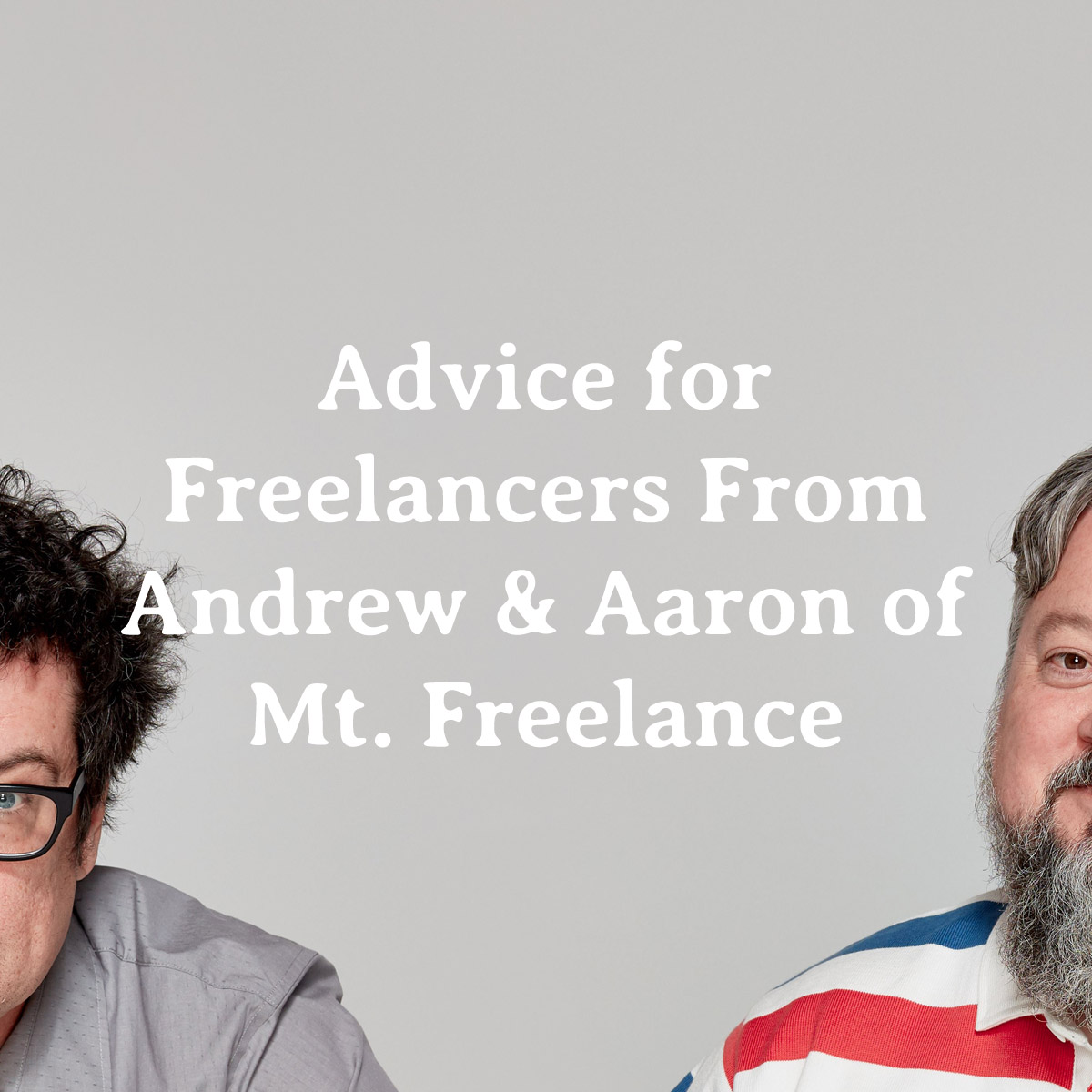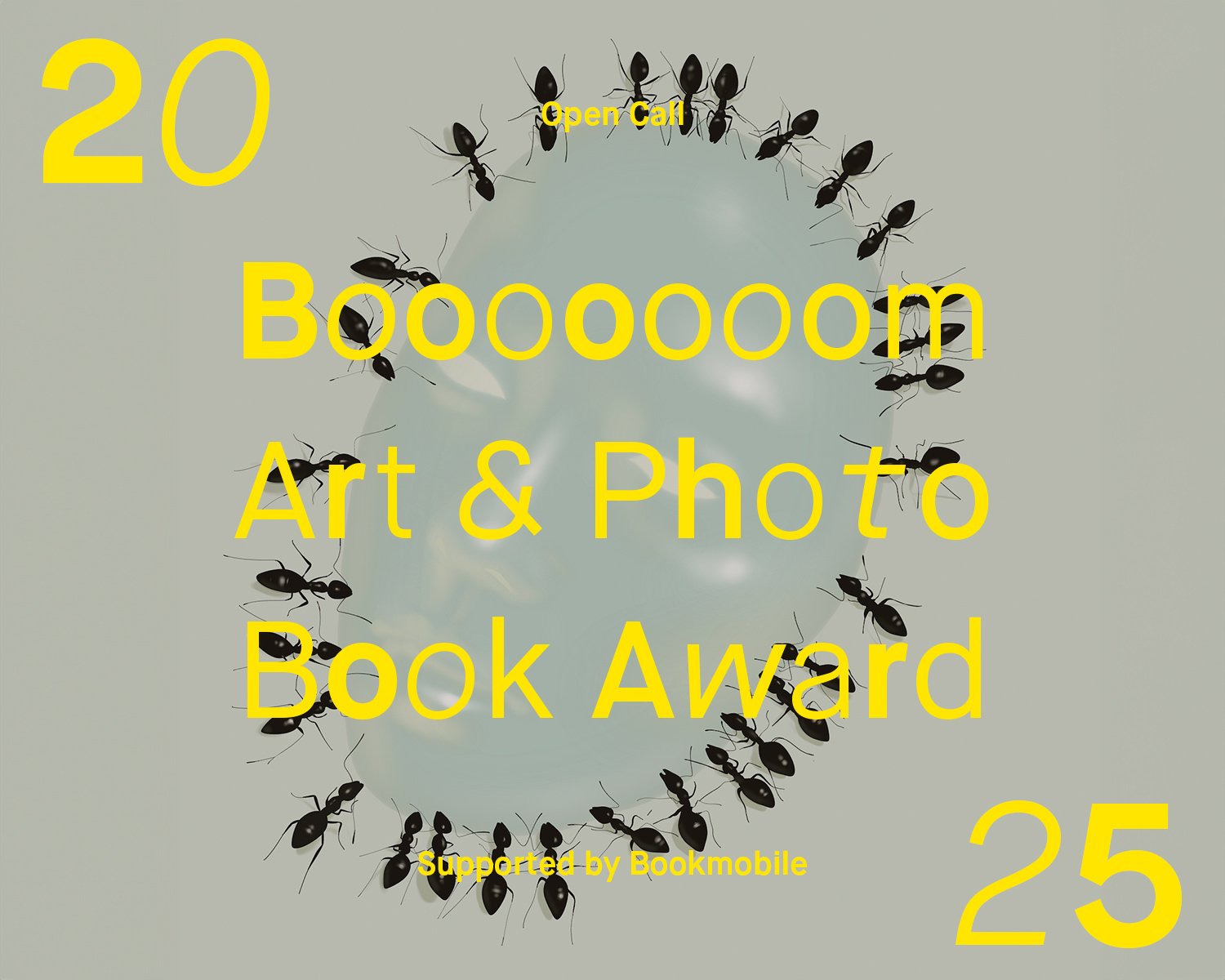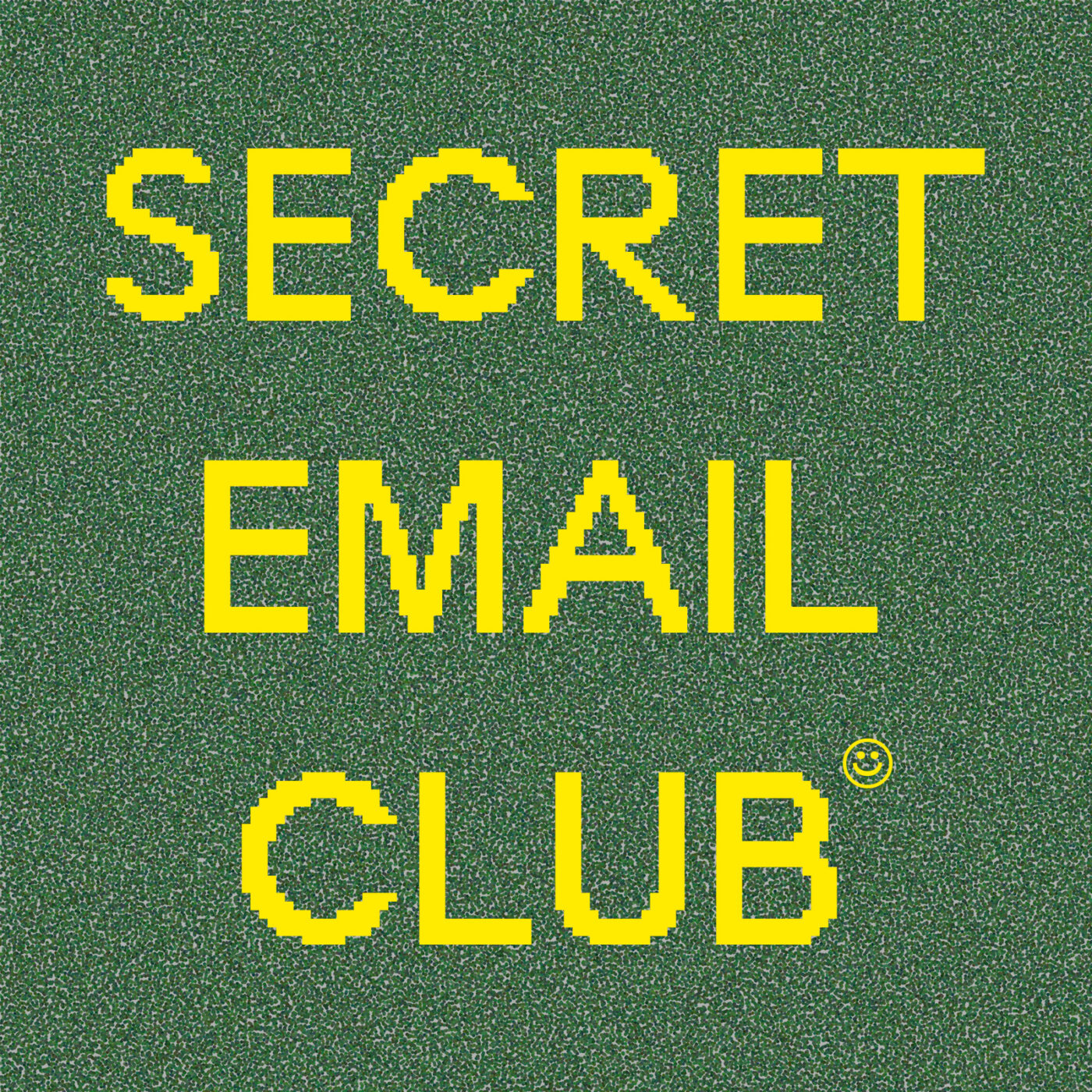Aaron James and Andrew Dickson are Portland, Oregon-based creatives with decades of freelance experience working with clients like Wieden+Kennedy, Apple and Kamp Grizzly. They recently put their heads together and designed a course called, Mt. Freelance, filled with stuff they wish they’d known when they were just starting out. Their goal is to “help freelancers freelance better”. They don’t teach how to design, but rather how to get work, charge what you’re worth, get rehired and run your business successfully.
You can check out Level 1 of their course for FREE here, and they’ve also hooked us up with a BIG discount on the full course. So if you want to dive deeper, use the discount code “BOOOOOOOM-300” on checkout or head over here to get $300 off.
Last month we gave you the opportunity to submit your own burning questions to Aaron and Andrew and we’ve compiled all their answers here! Thank you to everyone who took part (there were a few questions that were very similar so we merged a couple of them together). We hope you find their insights helpful!
How do I get attention from big customers like Nike, Coca-Cola, Facebook? I have been an art director and designer for over 10 years but I have never worked with major brands.
Aaron: Great question. As far as working for them directly it’s all about your network. Who do you know that works there or has worked there? If you strike out there, who do you know that knows someone there? If you have a contact, start a conversation. What’s it like? What kinds of people excel there? What kind of work are they looking for? Over a few conversations you might be able to get to a place where you are working together on a website upgrade and plan to reach out to a recruiter with an employee or respected former employee as your guide.
Andrew: There’s also working for an agency or studio that has a big brand as their client. They all have an agency of record, which can be as hard or even harder to get work with—Wieden+Kennedy Portland was actually the agency of record for all three of the brands you mentioned at one point. But brands like Nike and Coca-Cola in particular have literally dozens, if not hundreds, of other agencies they work with. Some of which are doing really interesting projects, many of which are easier to make connection with. These agencies tend to be close by, so for Nike, research Portland agencies, for Coca-Cola look around Atlanta.
Where do you start when you don’t feel as confident with your work as you would like to?
Andrew: A great place to start is going back to doing what you love doing the most. If you got into design because you made concert fliers in high school, or started out as an illustrator, or as a filmmaker go make some fliers or illustrations or a short film. Do what you really love and what gave you the confidence to be a designer in the first place.
Aaron: The other thing you do is, I’m going to say it again, lean into your network. Reach out to a friend and tell them you need a pep talk, or reach out to a collaborator and tell them you need some honest feedback. You could even reach out to a former client you did some solid work for and ask for a quote to use on Linkedin. Chances are there a lot of people who genuinely love your work and what you do.
Do you have any resources or advice for making simple freelance contracts without having to use an expensive lawyer?
Andrew: Believe it or not, neither Aaron or I create formal contracts. We both have clients that do, but when we have a client that doesn’t we actually do something else. We ask dozens of questions. From scope and deliverables, to timing and check-in cadence, to process and who else on the team and what everyone’s role is, to what form feedback is going to take.
Aaron: In our experience most of the problems and misunderstandings that can arise during a freelance job, and would require going back to a contract, can be avoided by over-communicating up front.
This is important with any client, but especially clients that aren’t particularly marketing savvy. And if you have this conversation in person or over the phone, follow up in an email with a clearly written out descriptions of everything you are agreeing to—deliverables, timing, rounds of check-ins and when feedback is to be delivered, and yes of course rate, and when you will be paid. Sometimes it can helpful to spell out what you are not delivering in this body of work to help ward off scope creep.
Andrew: So while it’s not a legally binding contract drawn up by a lawyer, you have it in writing, and more importantly you’ve made certain you are on the same page and agreeing to the same job as your client.
How did you go about creating systems and processes for your pipeline?
Aaron: As far as getting business, the most effective way is to do such a great job that your clients rehire you and refer you to other clients. If you can do that you will rarely have to look for work, and in fact will turn clients down, which will actually make you more desirable.
Andrew: This is about being really good at your job. But it’s also about positioning yourself to be really good at your job. As a rule of thumb, school and full-time employment are better places to learn on the job than freelancing. As a freelancer you job is to come in and do excellent work.
You should also strive for being quick and always over delivering. This is largely about how you frame a job. If a client asks for 15 logo options, you can say, ‘Sure, I’ll have them by Friday’. If you send over 20 on Thursday they are going to be blown away. Whereas if you send an almost done email on Friday, and send 12 on Monday, you’re not going to be as likely to get hired again, even if the logos are just as good.
I’m a South African illustrator and am struggling to get a reliable flow of work in. Any tips?
Aaron: First off, take a look at your website with fresh eyes. Do you look at it and think, wow, this person looks awesome to work with? Creating that reaction is about your work, but it’s also how you present your work, and how you present yourself and your process.
Second, are you doing everything you can to drive people to your site? Are you super active on Linkedin? I know it’s stuffy and businessy, but it is the platform where that type of networking is happening. Are you using a social channel to post work? Are you reaching out to prospective clients on social through follows and comments?
Lastly, are you cultivating a list of past clients and collaborators, and prospective clients and collaborators? If not, create these lists and make a point to reach out to everyone once every 3-4 months. The key is never to write, ‘Hey, I need work’. Check in with people, compliment projects they just launched, see what they are up to, and share new news about yourself. A website update, a new client project that is out in the world, an awesome personal project or even just happy personal news are all reasons to reach out.
How many projects/clients would you recommend taking on at once?
Andrew: That really depends on what kind of project and clients you have. If you are working for an advertising or digital agency and charging a day rate… probably just the one. Especially if you have some on-going smaller projects.
But assuming you are working hourly or project fee and have client work that tends to be on-going or part-time given the scope or their need to days or even a week to give you feedback… it really depends on how much you can handle and how hard you can work.
If you get overwhelmed and really like to focus, try and find bigger projects that will keep you busy for most of the hours of the day.
But if you like variety and work quickly see how many you can take on at once before things start to feel like they might get overwhelming.
The trick is you can’t miss deadlines, or start to forget to respond to client texts in a timely manner. Once you do that you risk losing a client for life or worse, having them speak negatively about their experience working with you.
What are some good initial opportunities to meet photographers and potential clients?
Aaron: Well, there is the normal answer, and then there is the quarantine answer. As we are in quarantine, we’ll go with the later. Linkedin is a great place to connect with people about work. And with most photographers unable to work right now, they are eager to connect with creative people who work with agencies and brands.
Be sure to check the feed, you’ll see what your connections are posting but also compelling things that are shared by people whom you might want to connect with.
Andrew: You should also hunt around for groups related to photography, production, and business that relate to clients you are drawn to. There are more of these groups than ever.
Question for each of you, what was a big mistake you made that you learned a lot from?
Aaron: When I was starting out as a freelancer I knew that I was going to have to pay a lot of taxes at the end of the year, but I really didn’t think through how much. I wasn’t putting aside a third or even a quarter of my income for taxes nor was I paying quarterly estimated taxes.
So come April, which is tax time here in the US, I had a huge tax bill. Much bigger than I imagined or could pay at the time. So I basically spent the summer working as hard as I could to catch up. That was rough.
Andrew: When I left W+K Portland I actually had a directing job already lined up and then I got a several months long gig at Facebook which took up the whole summer. I worked all year long until the next summer… when my work totally dried up.
I enjoyed myself for about two weeks and then I went into a full blown panic. Didn’t go on vacation, didn’t work on any personal projects, didn’t even go out much because I was worried about money and was hoping a job would come. It was another 8 weeks until I got another job and looking back I really squandered those 8 weeks waiting by the phone instead of being proactive about my business or enjoying the rare nice weather here in Portland.
Do you give repeat clients discounts according to frequency of work? If a client hires me once or twice a week to photograph their clothes collection for Ecom what amount of discount makes sense?
Aaron: If you are getting regular or long term work for a client it can make sense to offer a discount, provided you are currently making more than you need to. Especially if the client is easy to collaborate with, and the work is enjoyable or might help you get more work.
If on the other hand, you’re just getting by, giving a client a discount is going to stress you out, which isn’t a good recipe for doing good work. Another watch out is if the regular on-going work makes it harder to take on other potential work.
Andrew: If you ever need to give yourself a pep talk on charging a lot or sticking to your rate, remember that as a freelance you have to cover your own retirement, your own health insurance (at least here in the States), you own computer and desk, your own vacation time and sick days, and make enough to keep you going when work dries up.
As for your client, by hiring a freelancer instead of a full-timer they have one less retirement plan, health insurance, computer, desk, etc to pay for. Not to mention the cost of recruiting, training, and bonuses.
How do you pitch an idea (campaign/editorial/shoot) to a big brand and without a) Doing it for free, b) Giving your idea away, and actually be heard and considered?
Aaron: Pitching an idea to a big brand that isn’t already paying you or engaging you in a relationship is a long shot at best. While it’s tempting to think, ‘Hey, Nike has all the money in the world, I have this great idea! They’re going to love it’. The reality is every penny of their budgets are allocated through a complex system of departments, brand managers, teams and agency relationships with their own system of executive creative directors, creative directors and teams. You can’t just insert an idea into the process and have everyone stop what they are doing and embrace it, no matter how genius it is.
Andrew: As far as approaching a big brand, you need to work though this system, whether it’s cultivating a relationship with someone very high at the brand, or collaborating with the right people at the agency that does the kind of work you’re interested in.
The good news is that this system is a little easier to infiltrate at a medium sized brand and even easier for a small or micro brand. And it’s often smaller brands like start-ups and small businesses that are willing to do something provocative and interesting.
Do you ever feel trapped by your projects?
Aaron: Sure, I recently dipped my toe into doing a particular category of advertising work known for not being particularly interesting. It was good money and easy work, but not fulfilling and involved meeting after meeting. But the great thing is, once the job was over it was over.
Andrew: Something else you can try is phasing a project, especially if it longer. The way if works if you propose doing the first part, say the branding or the logo, for a certain amount. And then propose a second part, say the implementation of the branding or the entire visual identify, that will happen if and when the first part is complete and both parties want to continue. Especially if you are getting some red flags from a new client who maybe doesn’t have a lot of experience hiring creatives. This can be a really smart way to create an escape hatch before you sign up for a big project that might go sideways.
What are your routines and sources to pull yourself out of the quicksand when you are stuck with creativity?
Andrew: Change your routine! Try getting up an hour earlier, or spending the day having fun and getting started on work in the afternoon. Collaboration can also be a great way to get out of your rut, whether it’s patterning with a friend on a personal project or getting some feedback and ideas on your work from a trusted collaborator.
Even just getting up and going for a walk, exercising, reading the newspaper or flipping through your art books can help.
Aaron: I agree with Andrew on all of that, but I’m also a fan of working through your rut. I think there is this false notion that we can only be creative when we’re inspired or feeling it. But our job is to be creative. It takes hard work to do it, and if you’re reading this you’ve probably already put in years of hard work to get where you are.
So keep going. You won’t love everything you make, but you’ll keep moving forward and pushing yourself to find things you do like and creating space for happy accidents that can lead to your next big idea.
2025 Art & Photo Book Award
Wanna turn your art or photos into a book or a zine? Here’s your chance, we’re picking 9 people!
Learn moreJoin our Secret Email Club
Our weekly newsletter filled with interesting links, open call announcements, and a whole lot of stuff that we don’t post on Booooooom! You might like it!
Sign UpRelated Articles



